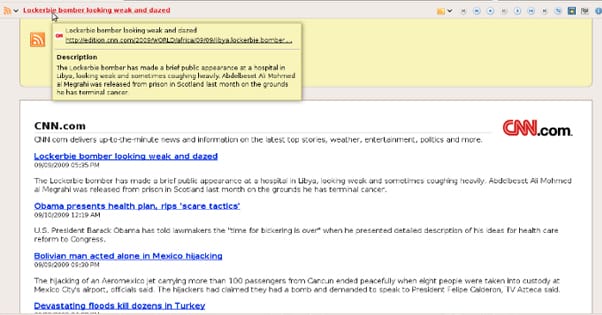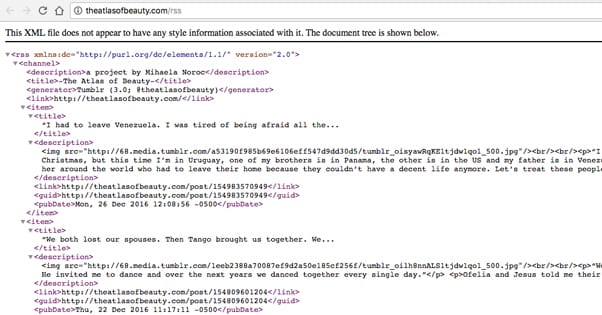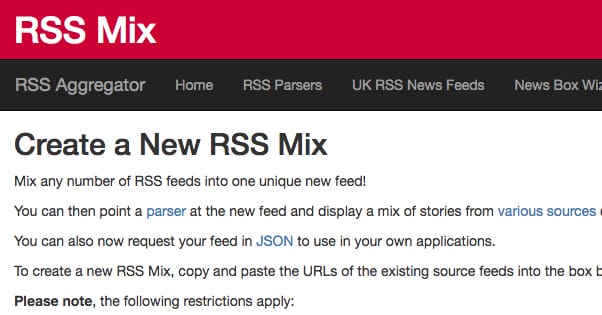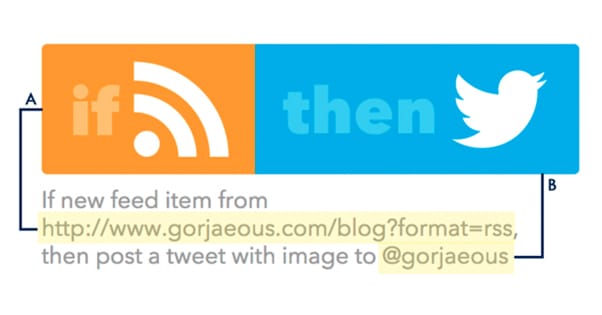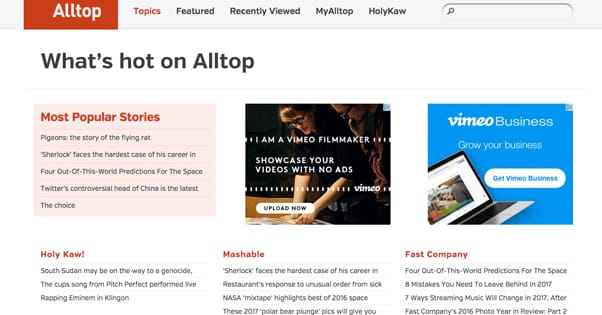Tutorial: Use An RSS Aggregator For Traffic Generation
Published by Drew Hendricks • Resources • Posted January 1, 2017 ContentPowered.com
ContentPowered.com
RSS is an older technology that is nevertheless still used in some segments of the internet population. The advent of social media took a lot of wind out of its sails, but it can still be used as a pretty effective means of traffic generation, if you know what to do. First, though, let’s cover the basics.
What is RSS?
RSS is a technology initially created in 1995, in the early days of the web. It stands for Rich Site Summary, though many people think of it and refer to it as Really Simple Syndication. Essentially, it was a replacement for either having to remember URLs for sites you liked to visit, or bookmarking them. Bookmarking in particular has issues where having to visit multiple sites just to see if they updated – or writing down their update schedules to check regularly – put a lot of burden on the user. How many of you out there would prefer to check a site daily in case there’s an update, when a better method exists?
RSS basically scans your site and creates a feed that contains little more than just the recent posts, their titles, some meta data, and a link. If this sounds like the Twitter feeds of some people you know, well, you’d be right.
The idea of the RSS feed is to make it easy for a user to see when new updates come in. RSS feed readers are programs users can install, and they can then subscribe to website feeds. When they check their reader, they see the most recent posts in their feeds, and can browse new content without having to load sites that haven’t been updated.
What is an RSS Aggregator?
An RSS feed is a stream of content from one single source, provided so that a reader or a browser can pull that information. A feed reader is an app that allows a user to subscribe to as many feeds as they like and see them all in their reader. An aggregator is like a reader with an output.
The RSS aggregator we’ll be using for this post is the WP RSS Aggregator. You plug in your feeds, as many as you have, and it outputs one single RSS feed that contains all of the content from each source.
How to Find Your RSS Feeds
Most websites have RSS feeds and don’t know about or use them. They come standard on WordPress and many other CMS platforms. Generally, all you will need to do is go to the home URL for the blog and add /feed to the end of it. For example, on Blogpros itself, if you go to blogpros.com/blog/feed, you get the RSS feed. You can see it here.
Blogs hosted on a Tumblr framework, you have to add /rss to the end of the URL instead. Tumblr blogs automatically have RSS as well. You can see an example here.
Now, you aren’t making much of an aggregated content stream out of just one blog, right? So, for this step, you need to find each RSS feed relevant to your presence as a brand and as an author.
First of all, you start with each site you own, as long as you don’t want to keep the dissociated from one another. Find the RSS feed for each blog you own and write it down.
Next, find sites you’ve written for and find your author page. For example, if you’ve written for the Huffington Post and they’ve given you an author profile page, you can find the RSS feed for that page by adding /feed to the end of it. A random author on Huffpo as an example can be seen here.
Some sites will redirect any narrow RSS feed like that to a central feed for their site as a whole. If this is the case, you will need to use a workaround. One such workaround is using Zapier to create a workflow that takes the primary RSS feed, filters it for just posts from you, and outputs your own RSS feed from it. Just make a new Zap with RSS to RSS, from the old to a new one, and use an author filter.
Find feeds for every place you publish content. Each time you pick up a new site, create a new site, or are accepted as a writer elsewhere, you can find their RSS feed and add it to your aggregator as well.
Combining Feeds with RSS Aggregators
I’m assuming you’re using the WordPress RSS aggregator I linked above, because it’s one of the easiest ways to do this. In it, all you need to do is click to add a new feed source and fill out the details. Details, in this case, include the name of the source, the feed URL, and… that’s it. You can put limits or link to the source feed if you want, or not.
Next, you go into the main plugin settings and set the custom feed URL and title. The default is /wprss, but it’s better to change it to something more unique and human readable.
If you don’t use WordPress, you can use a web hosted alternative like RSS Mix. It works the same way, except you have to rely on someone else’s server to pull and aggregate your conjoined feed, and that leaves you with the added risk and lack of control some people don’t like.
There is a certain element of SEO attached to RSS feeds. You’ll want to brand the feed and make sure there’s an element of branding in the content it publishes, other than your basic URL. Otherwise, for people who follow a lot of blogs, your content might not stand out as associated with you. Branding is always important for awareness campaigns.
Taking Advantage of RSS for Traffic
So what can you do with this core aggregated RSS feed? It has everything you write and publish, but how is it any different from having the URLs of those publications on hand?
For one thing, you can automate some basic social media promotion. IFTTT – or Zapier if you want to stick with one service – can make that very easy. Set the input to your recipe or zap as the aggregated feed URL, and set the output to be whatever social media post you want to use. In order to minimize the automated look, you should use wildcards and ingredients to customize the resulting post to make sure it looks organic.
Where can you post? With IFTTT automation, each time a post is published on one of your sources, it is pushed to your aggregated RSS feed, which is then pushed through the recipe and onto sites if your choosing. You can send it to Buffer, to Facebook, Twitter, LinkedIn, Google+, Reddit, Tumblr, or even another WordPress blog if you really want to get cyclical.
Another option is to publish a digest of new content notifications via email. You can create a mailing list for people who are most interested in your new content, and you can then set up RSS to Email in whichever email management system you want to use. MailChimp definitely has the feature, as does Get Response, and a wide range of others. Since RSS is so widely available and it costs nothing to implement RSS to email, most companies offer it as a standard feature.
The only downside to this method is the potential for spam. If you publish 2-3 blog posts a day, or even if you just have one coincidentally busy day, you can suddenly lose a ton of subscribers when they get three or four new emails from you notifying them of a post they haven’t seen.
Syndication is the name of the game with RSS, and you can use this setup to syndicate your new content to other blogs that allow duplicate or syndicated submissions. Sites like Social Media Today, Business2Commuinity, and Do We Comply all accept syndicated content, and I guarantee there are a lot more in your niche regardless of what that niche is.
Depending on the site, you may want to make some changes or generate a new aggregator.
- Some sites only want content from your main blog, so you would be limited to a basic RSS feed, not an aggregated feed.
- Some sites have blacklisted sites on their submissions, so if you write for one of those other sites, they will reject your feed because it would be promoting a competitor.
- Some sites will allow free submissions, while others will require that you go through a process to get an author account first. Make sure you have what you need before you submit your RSS feed to any site.
- Some sites will require that your RSS feed include the entire content of the post rather than just a summary or meta data. Make sure this is enabled if it’s something you want to do.
Also, make sure you don’t add your submissions to your aggregated feed. You might end up in a circular system, where a new post triggers the RSS feed which triggers a new post in an endless loop until someone notices and fixes it, generally by giving you the boot until you fix it.
Another good source of traffic is Alltop. Alltop is a blog directory – one of many, but a good one – that simply displays the most recent five posts from blogs submitted to their directory. They have industry categories to pick through, and it’s free to create an account. When you make an account, you fill out some information including your site category, and submit your RSS feed. Then you wait. An editor will check your feed and see if your recent content is good enough to curate on their site. If it’s up to the task, they approve you, and your feed provides them with content as long as you provide your feed with content.
While you’re at it, you can also investigate communities of people who may be willing to both subscribe to your RSS feed and promote it.
Subscribing to an RSS feed is a lot less common than it was a few years ago, but it can still happen, which is why promoting your aggregated feed is a good idea. People will subscribe and will be aware of your new content when it’s published. It’s something to do, not in replacement of social media, but in addition to it. Different demographics prefer different means of following their favorite authors, after all.
One such community that tends to use RSS more than most is Triberr. Triberr is a sort of LinkedIn for Influencers, a hub of blog publishers, editors, and influencers who interact with each other in tribes centered around people. Look for tribes that include people you know and who can vouch for you, and apply to them. Make sure to fill out your profile with a link to your aggregated RSS feed.
You know how blog comments can be a source of some minor exposure and traffic? Blogs that use CommentLuv are another good target for RSS interaction. By creating a CommentLuv account, you can use its integration on any blog that uses the plugin. When you comment on the blog post, you can choose a recent post, as pulled in from your RSS feed, to link. This link is actually followed and has a higher SEO value than just plain old blog comments, which are mostly ignored.
These are just a handful of examples of how you can use your RSS feed as a resource. Any time you can promote a link to your content, you can promote your RSS feed for an easy link to all of your content. And, any time you promote your RSS feed, anyone who likes and uses a feed reader can get their follow game on.

